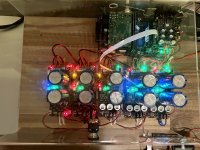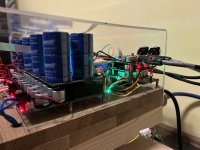Simply ground the whole stack to the ground wire coming in at the IEC connector/jack. Should be some grounding lug coming off the back of the IEC housing. Something is seriously wrong with the gear when you felt it at 100V. yicks!Hey, did you figure out if this is correct? Or how to connect the whole stack to wall earth like all electronics are?
My problem is I have no case to connect to, it’s wood and plexiglass for now. I’ve added the Dac with the OPA861 I/V and was wondering how can I ground all this to earth. Last time I used a device that wasn’t grounded properly, I felt some electricity when touching the cases. Measured it and it was almost 100v 🙂
FWIW, I just connect it to the safety earth ground line. In a case or on a board it still must be properly grounded IMHO. You could put a brass bolt in your wood board and use that point as a star ground to collect ground from everything. Run it to the safety 3rd wire. There are some good threads on grounding. Worth a read.Hey, did you figure out if this is correct? Or how to connect the whole stack to wall earth like all electronics are?
My problem is I have no case to connect to, it’s wood and plexiglass for now. I’ve added the Dac with the OPA861 I/V and was wondering how can I ground all this to earth. Last time I used a device that wasn’t grounded properly, I felt some electricity when touching the cases. Measured it and it was almost 100v 🙂
Thanks @redjr and @wlowes I too think everything should be properly grounded to earth ground line. I will give a read to the gorunding threads. Not sure what would I ground from the Ian stack, other than connecting the StationPi Pro TP1/TP2 to earth. Separately the MPAudio toroidal trafos each has a gounding wire which I've already connected to earth in a star-like config to the IEC.
Here's the definitive authority on grounding, by Dave Davenport.
@Lso & @iancanada, I have also confirmed Ian's Dual Mono EA9038Q2M DAC will power up ok & play ok without VCCA powered.
I have not tried to assess any SQ differences at this point. Probably won't get to that tonight.
Nor have I tried reconfiguring the DAC back to ASRC mode to confirm whether it works ok in that mode without VCCA. Likely let someone else do that.
Ian, excited by your new clocks! Take my money, please!
I have not tried to assess any SQ differences at this point. Probably won't get to that tonight.
Nor have I tried reconfiguring the DAC back to ASRC mode to confirm whether it works ok in that mode without VCCA. Likely let someone else do that.
Ian, excited by your new clocks! Take my money, please!
Very interesting change. I’ve struggled with soldering all 10 caps, maybe longer pins will help? Does anyone have any tips on soldering the Maxwell caps to Ian’s board? I always have to revisit the soldering as it’s not making contact to the board properly.
You may need a higher power soldering iron...I know I did for the ultracaps. Especially the ground side can soak up a tremendous amount of energy/heat so the larger iron helps the cap pin get to heat more quickly.
Thanks for the tip @acg. I got an 80W soldering station, a larger tip for better heat transfer. The temp set to 280-300C. The solder melts pretty fast. I think I might need more practice to acquire more skills for this type of soldering. And maybe some proper flux rather than the paste that I have.
Or maybe a higher power soldering iron like you said, but not worth the investment right now. 10 caps done, waiting for the trafos so I can power them up simultaneously 🙂
Or maybe a higher power soldering iron like you said, but not worth the investment right now. 10 caps done, waiting for the trafos so I can power them up simultaneously 🙂
Not sure if this is the right thread, but I wanted to ask if the ReceiverPI Pro with its HDMI input is suitable for capturing HDMI audio from a TV (HDMI eARC) and passing it through to the USB DAC and eventually to the amplifier? I want to automate switching sourcesbetween my RPi 4 streamer (running Moode) and my LG TV, like done in modern streamers such as Bluesound Node that have HDMI eARC input.
Thanks for clarification! I might look into HDMI eARC capture modules and see if I can pass it through Raspberry Pi that way.
Many TVs have Toslink optical outputs, which could input to the ReceiverPi Pro. If your TV doesn't have one, then you have to find a deembedder box that can take audio off the HDMI.
Somehow this is an obvious idea that didn't cross my mind. I already plug my TV to the integrated amplifier via optical output - I might as well do it via streamer and write a script that could do input signal detection. Thanks!
For heavier connections, I raise the temperature up to 400 degrees Celsius. Sometimes more for mechanical parts, e.g. IEC inlet. Try to limit the soldering time.Thanks for the tip @acg. I got an 80W soldering station, a larger tip for better heat transfer. The temp set to 280-300C. The solder melts pretty fast. I think I might need more practice to acquire more skills for this type of soldering. And maybe some proper flux rather than the paste that I have.
Or maybe a higher power soldering iron like you said, but not worth the investment right now. 10 caps done, waiting for the trafos so I can power them up simultaneously 🙂
@iancanada
The OPA861 manual states that the RCA connections are only for testing purposes. Is that because they are not balanced, like the XLR connections?
Gabster brings the RCA connections to the outside of his case, since he very critical on quality, I assume that the XLR and RCA connections carry the same signal, Vout- & Essl+.
The OPA861 manual states that the RCA connections are only for testing purposes. Is that because they are not balanced, like the XLR connections?
Gabster brings the RCA connections to the outside of his case, since he very critical on quality, I assume that the XLR and RCA connections carry the same signal, Vout- & Essl+.
If I understand correctly what you are trying to achieve, you will not need additional script. I have optical output from TV connected to Ian's Receiver board and if TV is on, system plays TV sound, if I want play music from Roon end point running on Raspberry Pi, I turn off the TV and streamer plays music from Raspberry Pi.Somehow this is an obvious idea that didn't cross my mind. I already plug my TV to the integrated amplifier via optical output - I might as well do it via streamer and write a script that could do input signal detection. Thanks!
Hi all! I’ve finally received the last parts for my Ian Canada streamer-dac build. Last for now, who knows what I’ll do in the future 😁
List of parts: RPI 4B, Station Pi Pro, FifoPi Q7 with Accusilicon AS318B 45MHz and 49 MHz, 9038Q2MPi dual mono Dac and the Ed’s controller, OPA861 I/V, LinearPis and UcConditioner with Maxwell caps (5pieces) and 3 audio grade trafos from MPAudio 2x6VAC/60VA each.
One power supply for the station + rpi, one for the FIFO, one for the dac and two in series for the opa.
Currently running on RCA as I am limited to that due to the amplifier (Wadia Intuition). I’ve just set the dac in true sync and I can just say it sounds amazing. Very detailed but at the same time very relaxed and natural, no harshness unless the recording is harsh. Can’t wait for daylight so I can listen more and louder.
Thanks all that have helped and thank you @iancanada for the great products and the help!
Attaching some pics of the current state of the build. The “case” will be changed to a “cleaner one”, better cuts and more permanent holes.
LE: added a pic with the full system. Speakers are a pair of DIY enhanced “clones” of Monitor Audio Pl200mk2 with an additional mid range on top (not my work).
List of parts: RPI 4B, Station Pi Pro, FifoPi Q7 with Accusilicon AS318B 45MHz and 49 MHz, 9038Q2MPi dual mono Dac and the Ed’s controller, OPA861 I/V, LinearPis and UcConditioner with Maxwell caps (5pieces) and 3 audio grade trafos from MPAudio 2x6VAC/60VA each.
One power supply for the station + rpi, one for the FIFO, one for the dac and two in series for the opa.
Currently running on RCA as I am limited to that due to the amplifier (Wadia Intuition). I’ve just set the dac in true sync and I can just say it sounds amazing. Very detailed but at the same time very relaxed and natural, no harshness unless the recording is harsh. Can’t wait for daylight so I can listen more and louder.
Thanks all that have helped and thank you @iancanada for the great products and the help!
Attaching some pics of the current state of the build. The “case” will be changed to a “cleaner one”, better cuts and more permanent holes.
LE: added a pic with the full system. Speakers are a pair of DIY enhanced “clones” of Monitor Audio Pl200mk2 with an additional mid range on top (not my work).
Attachments
Last edited:
Nice. I like the plex-glass cover. It's always nice to see inside and what's making the music - especially all the color LEDs Ian uses.
Enjoy.
Enjoy.
a wooden case built around it, ian canada isolator II, FifoMA 1.5, PuprePi 3.3-5 volts.
a nice volume knob is also being made on a lathe.
been running for a while now and sounds great.


a nice volume knob is also being made on a lathe.
been running for a while now and sounds great.
Right, so it always passes through the input via SPDIF to the RaspberryPi output, and potentially can play two things at the same time. I guess the only remaining bit would be to be able to switch the RPi streamer on when there is an audio signal from the TV, I was hoping that HDMI interface would allow to achieve this, but ultimately this may be too challenging to implement.If I understand correctly what you are trying to achieve, you will not need additional script. I have optical output from TV connected to Ian's Receiver board and if TV is on, system plays TV sound, if I want play music from Roon end point running on Raspberry Pi, I turn off the TV and streamer plays music from Raspberry Pi.
If I remember correctly, according Ian's manual for ReceiverPI incoming signal from external source is primary and RPI signal is secondary, therefore you need to turn off TV, when playing music from RPI.Right, so it always passes through the input via SPDIF to the RaspberryPi output, and potentially can play two things at the same time. I guess the only remaining bit would be to be able to switch the RPi streamer on when there is an audio signal from the TV, I was hoping that HDMI interface would allow to achieve this, but ultimately this may be too challenging to implement.
- Home
- Source & Line
- Digital Line Level
- Asynchronous I2S FIFO project, an ultimate weapon to fight the jitter



